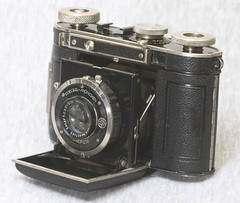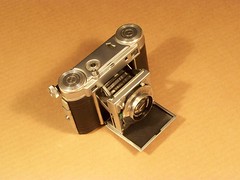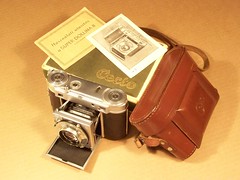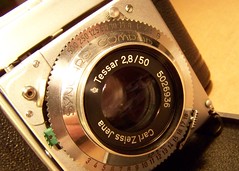The Dollina is a series of 35mm folding cameras produced by the German maker Certo based in Dresden. There were three generations of Dollina, each with a different body.
The first generation: Dollina 0, Dollina I, Dollina II[]

|
| Dollina I, with Xenar f/2.9. Picture by Jack Hufnagel. (Image rights) |
The first model was the Dollina I, a horizontal-bed folding 35mm camera with a simple viewfinder, and the focus knob on the top plate. The shutter was a Compur 300. The lenses included:
- Meyer Trioplan 5cm f/2.9 (3 element)
- Schneider Radionar 5cm f/2.9 (3 element)
- Schneider Xenar 5cm f/2.8 (4 element)
- Schneider Xenar 5cm f/2.9 (5 element)
- Steinheil Cassar 5cm f/2.9 (3 element)
The Dollina 0 was a cheaper version, with 3 element lenses and front cell focusing. The choice of lens and shutter for the Dollina 0 included:
- Certar 5cm f/4.5 with Automat 25-100
- Certar 5cm f/4.5 with Vario 25-100
- Certar 5cm f/4.5 with Pronto 200
- Certar 5cm f/2.9 with Compur 300
 
|
| Dollina 0 and Dollina II in a Certo catalogue. (Image rights) |
The Dollina II was a more expensive version, with a coupled rangefinder unit above the top plate. It is operated by the top focusing knob, and the viewfinder and rangefinder windows are separate. The Dollina II existed in black finish (earlier version) and in chrome finish (later version). The Dollina II was a mid priced camera; in 1938, a Schneider Xenon lensed model sold in New York for $57.50 US, or about $859 Us in 2007 terms. This was about half the price of a Xenon lensed Retina II or Weltini.
The shutter was either a Compur 300 or a Compur-Rapid 500.
1936---- Dollina ll rarer version:Smaller rectangular window and smaller circle in Rangefinder: NO serial # Very Rare!
The choice of lenses for the Dollina II included:
- Schneider Radionar 5cm f/2.9 (3 element)
- Schneider Xenar 5cm f/2.9 (4 element)
- Schneider Xenar 5cm f/2.8 (5 element)
- Schneider Xenon 5cm f/2 (6 element)
- Schneider Xenon 4.5cm f/2 (6 element)
- Steinheil Cassar 5cm f/2.9 (3 element)
- Carl Zeiss Jena Tessar 5cm f/2.8 (4 element)
 
|
 
|
| Dollina II, Compur-Rapid, Radionar f/2.9. Pictures by Basic Framework. (Image rights) |
Dollina lll c1939:
Tiny rangefinder windows incorporated in the baroque shaped body, below the flat chrome top deck . Three large knobs on top of equal size, focus is in the center, large plunger rod shutter release, large film counter reset on top deck. Distinct angled forward shaped 45mm thick body, 115mm wide, 580.97g weight ( Heavy- Brass). Camera is stamped with" Dollina" large letters, Certo Dresden in small letters. Two small viewfinder windows on the left side back.
Split image rangefinder 6.5mm circle with 2mm insert of viewing(Tiny). Gear film advancing release on right side back(Often Jammed) , Large D.O.F guide on back of camera. Camera Serial # range 15,283. Shutter Compur Rapid T,B,1~500. lens CZJ Tessar 5cm F:2.8 or 4 element design Xenar & Xenon F;2 also possible. Vertical drop down door of metal with Dollina in center chrome plate at tilted lettered angle. Scarce to rare camera, Best workmanship of the Dollina series. Note: NOT marked Dollina lll, not too be confused with the Super Dollina of c1939
The Dollina III[]
The Dollina III was a high-end model, with a focusing wheel above the top plate like the previous models, and a coupled rangefinder integrated in a new body with a baroque shape. The folding bed is a flat square plate, and the two sides of the body protrude together to leave room for the lens and the rangefinder. The shutter was either a Compur 300 or a Compur-Rapid 500. The choice of lenses for the Dollina III included:
- Schneider Radionar 5cm f/2.9
- Schneider Xenar 5cm f/2.8
- Schneider Xenon 5cm f/2
- Steinheil Cassar 5cm f/2.9
- Carl Zeiss Jena Tessar 5cm f/2.8
The Dollina III was short lived and replaced by the Super Dollina, and today it is the most uncommon of the Dollina models.
Super Dollina 1939 , Super Dollina II 1951[]

|
| Super Dollina, with Xenar 5cm f/2.8. Picture by Yet To Come. (Image rights) |

|
| Super Dollina in a Certo catalogue. (Image rights) |
The Super Dollina replaced the Dollina III as the top of the range. It also had a coupled rangefinder integrated in the body, but this new body was more rounded and compact, similar to the Dollina I and II. The viewfinder and rangefinder windows were separated. The focusing wheel was sticking out of the right side of the top plate. The Super Dollina had two thick buttons for advance and rewind, and was made at least until the war. The shutter was either a Compur 300 or a Compur-Rapid 500. The choice of lenses for the Super Dollina included:
- Friedrich Doppel Anastigmat Corynar 5cm f/2.7
- Meyer Trioplan 5cm f/2.9
- Schneider Xenar 5cm f/2.8
- Schneider Xenon 5cm f/2
- Steinheil Cassar 5cm f/2.9
- Carl Zeiss Jena Tessar 5cm f/3.5
- Carl Zeiss Jena Tessar 5cm f/2.8

|
| Super Dollina II, with Tessar f/2.8. Picture by Alf Sigaro. (Image rights) |
After World War II, it was replaced by the Super Dollina II with slim buttons for advance and rewind. The shutters on the Super Dollina II included:
- Cludor 200
- Vebur 250
- Compur-Rapid 500
- Synchro-Compur 500
The choice of lenses for the Super Dollina II included:
- Ludwig Meritar 50mm f/2.9
- Rodenstock Heligon 50mm f/2 (probably for exportation, together with a Synchro-Compur 500)
- Carl Zeiss Jena Tessar 50mm f/3.5
- Carl Zeiss Jena Tessar 50mm f/2.8
The Super Dollina II was in production for a very long time, until the beginning of the 1970s. It was also sold under the name Super 35.
 
|
 
|
| Super Dollina II, Tessar f/2.8. Pictures by Laszlo Gerencser. (Image rights) |
The offshoot: Durata, Durata II[]
The Durata was a less expensive variant of the Super Dollina II produced after the war, without a rangefinder. The first model had a folding optical finder. The shutters included the Prontor II. The lenses for the Durata included:
- Rodenstock Trinar 4.5cm f/3.5
The Durata II was the following model, with a top plate integrating the viewfinder, and bearing a closer resemblance to the Super Dollina II. The shutters included the Cludor 200. The lenses for the Durata II included:
- Meyer Trioplan 50mm f/2.9
Links[]
General links[]
In English:
- Dollina section on Retrography.com by Simon Simonsen, Denmark
In Japanese:
Repairs[]
In Japanese:
Manuals and documentation[]
In English and Hungarian:
- Hungarian manual for the Super Dollina II (pdf format), with an English translation by Laszlo Gerencser